
- Red Search
- Resources
- Voice Search Statistics Australia
Voice Search Statistics Australia (2024)
-
 Daniel Law
Daniel Law
- Updated: August 9, 2024
Voice search has become indispensable as Australian households and businesses now rely on smart speakers and smart home devices. In 2024, we looked into user behaviours, emerging trends in market growth, and tech improvements to gain valuable insights into the future of voice search.
Understanding these trends can help households and businesses stay ahead in Australia’s rapidly evolving digital landscape. But when and how do Australians actually use voice search in their everyday lives?
In the following sections, we break down the latest voice search statistics, how it has changed how Australians search online, and what it can do for your business.
What Is Voice Search Technology?
Voice search utilises audio input from spoken words or phrases to find information or command a compatible and connected device. The technology allows its users to speak to the device and then interpret the words or phrases to respond to fulfil the command (see user search intent).
In summary, voice search allows users to interact naturally with smart devices and voice assistants. It allows users to work faster, more efficiently, and more accurately than typing, browsing, or navigating between buttons.
Voice search is revolutionising smart devices by making them accessible and useful to everyone. By 2024, more devices will have voice search enabled and be able to use it for hands-free browsing.
Devices with Voice Search Technology
Voice search-equipped devices can be as big as your PC or something smaller than your smartphone. Think of home assistants and smart accessories such as:
Smart Home Devices
These include AI-enabled home devices like Amazon Alexa, Google Nest, and other home assistants that can control your lighting, set the mood with the right music, control the thermostat, and lock/unlock the door at your command.
Voice Assistants
Samsung Bixby, Apple Siri, Google Assistant, Amazon Alexa, and Microsoft Cortana are just a few voice assistants that could help you complete tasks on your phone, tablet, or PC using your voice. That includes setting up a meeting appointment, browsing for a search query, calling a friend, or planning a workout routine.
In Australia, Apple owns roughly 54.16% of the mobile vendor market share. It’s safe to say that roughly the same portion of device owners use Apple Siri as the country’s most popular AI voice assistant, followed by Samsung at 27.05%, and Google at 8.8%.
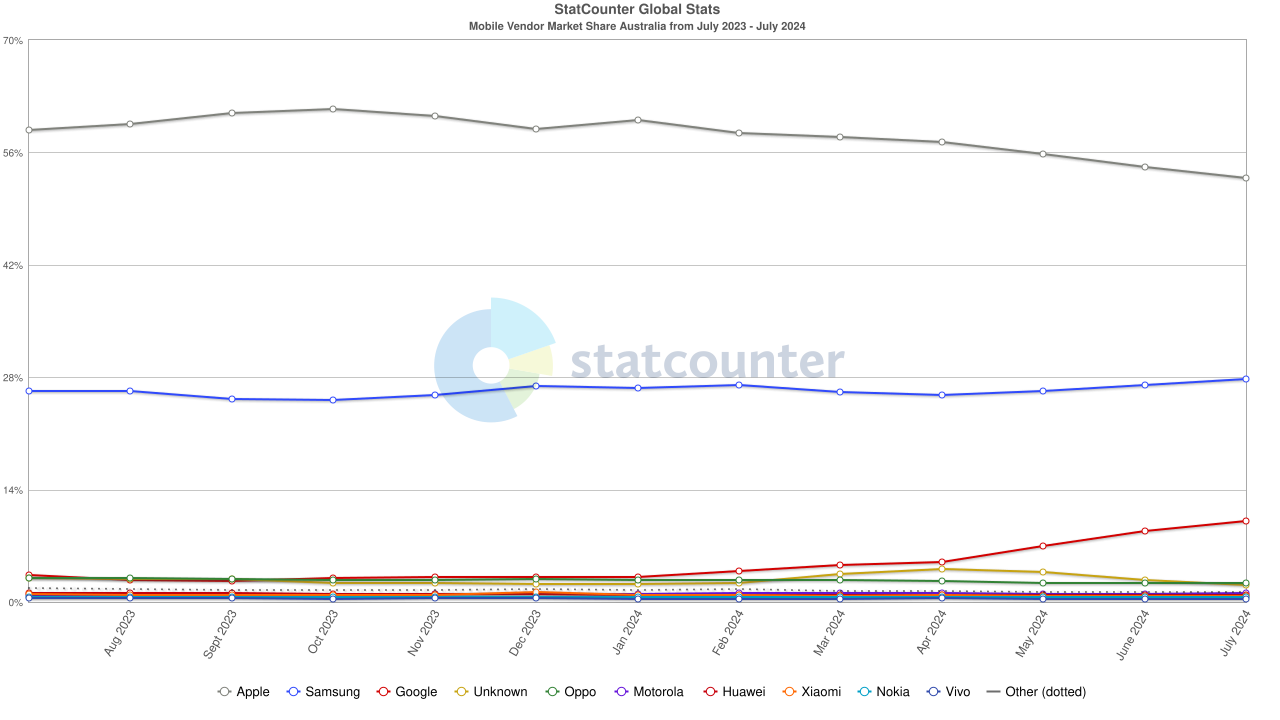
Source: Statcounter
In-Ear Smart Earbuds
People looking for smart devices that can keep up with a fit lifestyle will appreciate in-ear smart earbuds with voice control and assistant capabilities.
These smart devices integrate with Google’s services to allow their wearers to perform voice searches. They can also perform basic tasks like placing calls, controlling music playback, and using advanced technologies like active noise cancelling.
The Latest Voice Search Statistics in Australia
With the advent of smart innovations such as voice search technology, this feature has changed how we search online.
As marketers, we must understand the most relevant voice search statistics to enable us to craft successful, user-focused digital marketing campaigns.
1. 40% of Australians own a Google Home smart speaker
The latest survey on smart speaker ownership reveals that Australians have fully embraced smart speaker adoption, as 40% of surveyed households (463 respondents) as of March 2024 own a Google Home smart speaker.
Following the list, 31% of households reported using an Amazon Echo device, while 21% used Google Next. Only 19% claimed to use an Apple HomePod at home, which is quite the opposite of mobile device ownership for the same company.
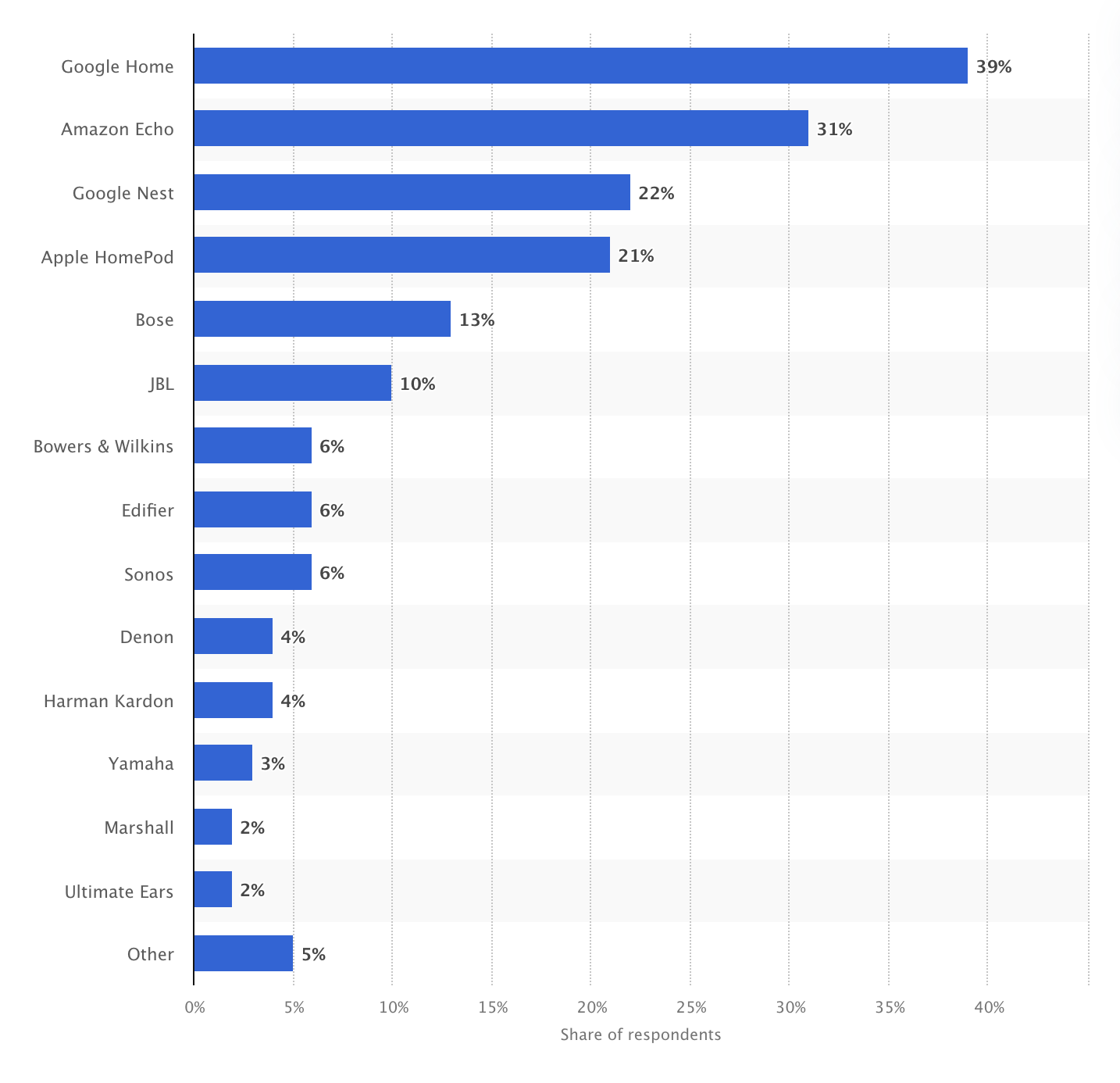
Source: Statista
2. The Global Smart Speaker Market is projected to reach AU$168.22bn by 2033
With AI virtual assistants becoming more powerful and integrated into smart speakers, the industry is projected to reach up to AU$168.22bn with a Compound Annual Growth Rate (CAGR) of 32.5% by the end of 2033.
At the latest, the global smart speaker market sales for 2024 may exceed AU$22.94bn, becoming the top-selling consumer electronics.
3. 28% of Australians used a Voice-Activated Speaker in 2023
An ACMA study shows that almost 28% of Aussies have reportedly used a smart speaker in 2023, showing a consistent rise YOY and increasing adaptation of voice-activated speakers.
Australia follows Canada with 30% ownership, with the US at the top spot with 35% ownership of smart speaker devices.
Another statistic from the 8th Annual Infinite Dial revealed that Australia managed to sit on par with the US in terms of smart speaker ownership, currently equal to 34%.
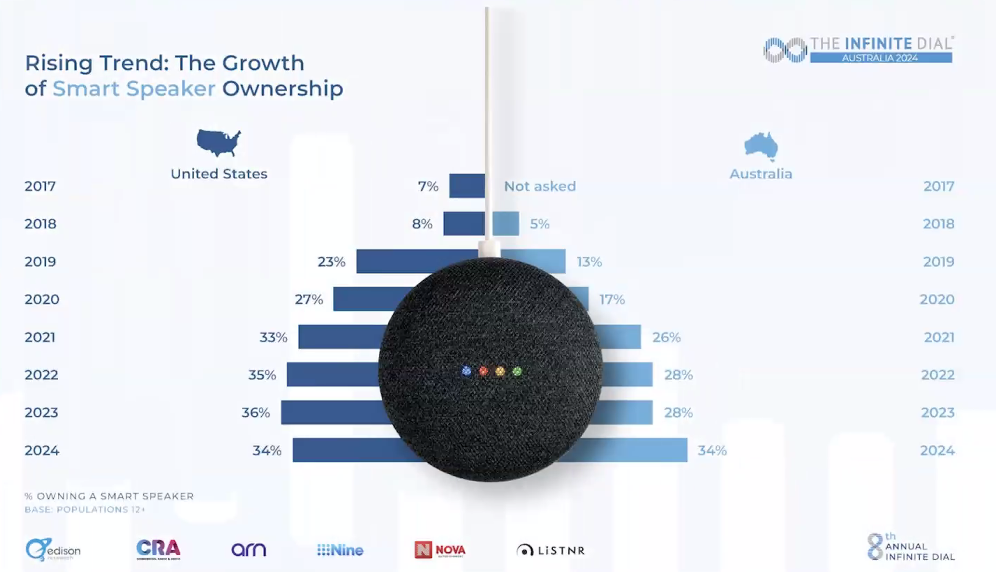
Source: RadioInfo
4. Voice assistant devices continue to grow
Australia’s speech recognition market currently has high demand from critical industries like banking, healthcare, and retail. It’s predicted that Australia and Oceania’s speech recognition market will reach AU$222.21 million in 2024, with a CAGR of 14.25% from 2024 to 2030. By then, it should hit AU$494.11 million.
5. Voice search and commerce spending grew up to $19.4bn, up 300%
As more businesses shift their focus to voice search and voice commerce, spending reached record amounts up to $19.4 billion, a 300% growth in only 2 years. This highlights the potential of voice search as a business tool and how businesses perceive it as a powerful tool to drive sales and become the next big thing in commerce.
6. 90% of users say voice search is faster and more convenient than traditional text-based search
9 out of 10 Aussies believe the hands-free capabilities of voice search make it a more convenient and quicker option to search for stuff on the go or at home than traditional text-based search.
How Australians Use Voice Search-Operated Devices
Voice search technology is constantly improving, fueling a new wave of innovation. This smart technology has significantly contributed to Australians’ daily lives, whether at home or work.
“The increasing prevalence of smart speakers in Australian households extends access to radio to more places and more devices and demonstrates that consumers value audio and are open to the increasing possibilities of voice assistant technology,” said Joan Warner, chief executive officer of Commercial Radio Australia.
Using voice-assisted technology on your smart devices is an excellent way to complete tasks quickly.
Check out how smart speaker owners use their devices below:
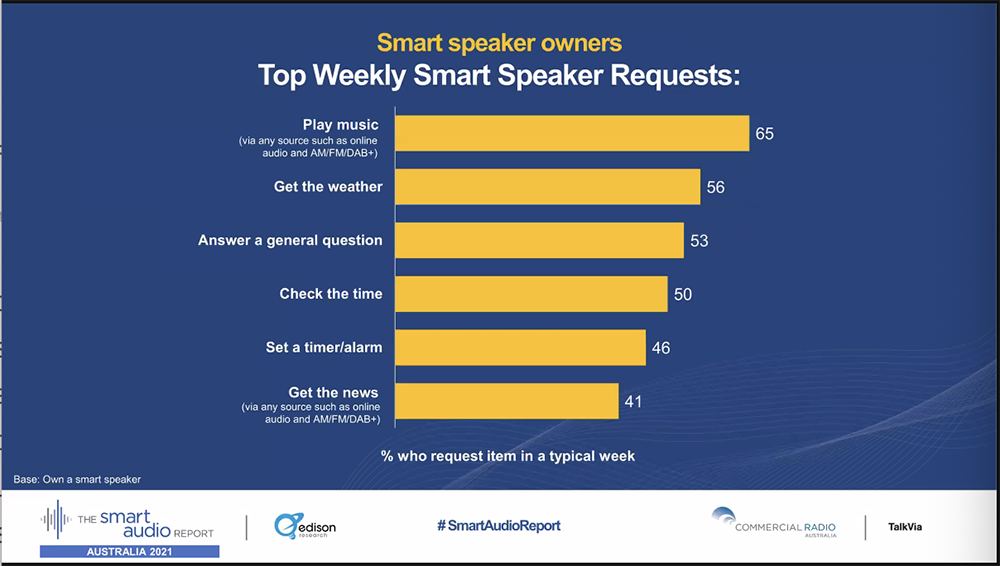
Source: Radioinfo
- 65% listen to music on smart speakers
- 56% use the device to check the weather
- A voice-assisted device is used by 53% of people to answer a general question
- 50% use the device to check the time
- 46% of people use it to set an alarm
- 41% use a smart device to stay up to date on current events
Other key findings from The Smart Audio Report Australia show how Australians use voice-operated devices.
A New Way to Tune In to Radio
With Australia’s smart speaker ownership growing by the year, RadioInfo reported that 65% of owners used smart speakers to listen to the radio in the past month (June 2024). In 2017, the devices weren’t even mentioned!
Doing chores with a voice-assisted device
67% of smart speaker owners listen to the device to help them with household chores. During a typical week, 63% listen while cooking and 57% listen for entertainment.
How Voice Search Impacts eCommerce
Voice search on mobile or any smart device transforms the ever-changing eCommerce landscape. To engage your customers more, see how they interact with voice-assisted devices below.
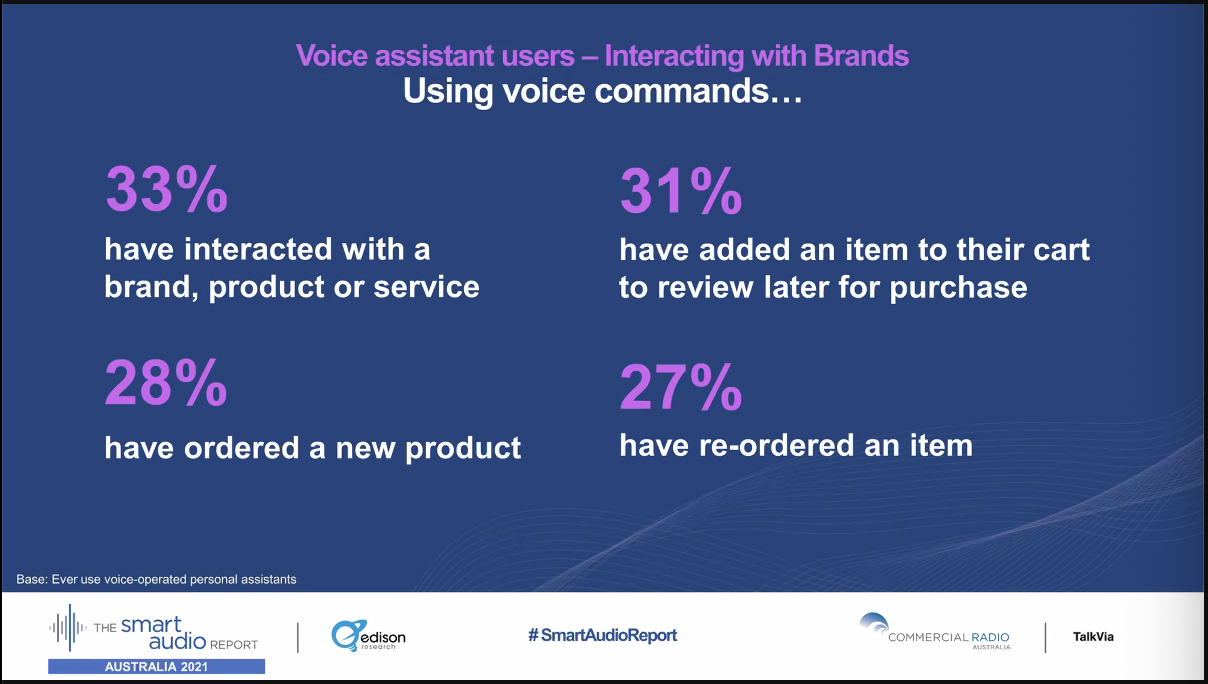
- 33% use a smart device to interact with a brand, product, or service
- 31% use the device to add an item to their cart, which will then be reviewed for purchase later
- 28% order a new product using a voice-assisted device
- 27% use the device to re-order an item
Shopping or purchasing online is now easier than ever, thanks to the rise of voice search and ease of shopping through mobile devices.
Final Thoughts
Voice search evolved from a mere Google feature into a full-blown addition to smart device technology, AI-assisted functions, and lifestyle tools. You’ll find voice search enabled and embedded into smartphones, smart speakers, earbuds, and all other smart accessories connected to multiple devices or the cloud.
As voice search becomes necessary for households and businesses, its usage trends, market share, and ownership in Australia will vary, grow, and evolve as more people realise searching for information no longer takes a press of a button.
Utilise the statistics mentioned earlier to your advantage for growth and management. With the advancement of voice search technology in recent years, it’s needless to say, it has undoubtedly changed how many of us have started searching online.
For more about leveraging the latest search trends to accelerate growth in your business, speak to our SEO Sydney specialists today.
Also, make sure to check out our other statistic articles below!
Written by





